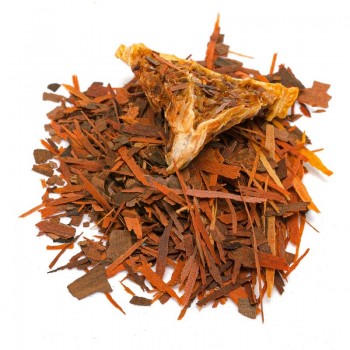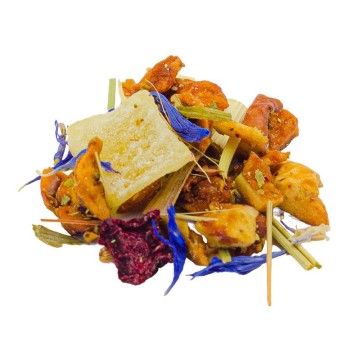This blend is rich in aromas and flavors with multiple spicy, citrus, fruit and citrus nuances. The result is an unmistakable taste, with exotic and fresh notes on the palate. A strong spicy and citrus base, with a sweet and energetic finish - a pinch of Japan Genmaicha green tea adds punch to the infusion. Delicious iced for the summer, it is refreshing and thirst-quenching; ideal as an aperitif and especially after meals, to facilitate digestion. Tasty and warm, however, in winter it helps in the well-being of the nose and throat.
Ginger mint mandarin infusion: properties and benefits
This mixture represents a natural remedy useful for digesting better, after bloating from a heavy dinner or after consuming foods that are not easily digestible. Its properties contribute to faster postprandial relief, stimulating the assimilation of food and reducing problems related to stomach heaviness. The ginger, mint and mandarin infusion offers a mix of ingredients that reduce the sensation of bloating and flatulence, thanks to their natural carminative qualities. In addition to promoting regular gastrointestinal motility, herbal tea is useful for eliminating gas - also thanks to the presence of carrot and orange.
The combination of ginger and mint, in particular, has properties that help soothe stomach irritations and anti-nausea properties. For those who want an infusion that counteracts intestinal disorders linked to the menstrual cycle, ginger and safflower favor this action.
The infusion can be useful for purification, after a heavy meal or as part of a detox diet. Carrot and green tea promote the drainage of body fluids and the functionality of the urinary tract. Following a detox diet, ginger and green tea help increase body temperature (thermogenesis) and speed up the metabolism. A process that facilitates the fat burning effect and calorie consumption.
Herbal tea can be useful, taken hot, for the well-being of the nose and throat, with its balsamic effect due to the apple and ginger.
Origins and history of cultivation
Ginger is a plant native to Asia, appearing for the first time in the southern areas of China or Southeast Asia, according to several studies. From there it spread to the rest of Asia, India, the Maluku Islands (the so-called Spice Islands) and West Africa. Its name "ginger" has a root in the Sanskrit word "srngaveram" which means "horn root" and describes the rhizome (underground root) from which the spice is derived.
It arrived in Europe around the 1st century, when the ancient Romans traded spices with India, including ginger. After the fall of Rome, it was Marco Polo in the Middle Ages who brought it back from his trip to the East and revived it as popular. At the time, ginger was expensive and valuable, used for dishes and as a natural medicine. In the 15th century, ginger was brought to the Caribbean, where it began to grow easily. Today the largest producer of ginger in the world is India. The rhizome is harvested when the stem of the plant withers. Ginger rhizomes are used freshly harvested, dried and pickled.
Mint has been cultivated for millennia and, according to some scholars, it would be practically impossible to find it in nature in its original form. It was already known in some texts of the Bible, and in ancient mythology it is said that mint derives from a rival of Proserpina, wife of Pluto, transformed into the mint plant. In ancient Athens, mint was a perfume used on the arms. Widespread in other parts of Europe during the Middle Ages, it was already known as a remedy for whitening teeth, for digestion and for flavoring sauces. To date, many hybrids and cultivars of mint are known, which has a distribution in many parts of the world, including Africa, Australia and America.
Fruits and flowers
Ginger is a flowering plant, the Zingiber officinale of the Zingiberaceae family. it loves mild climates and its cultivation is more effective in tropical and subtropical climates. It thrives in lots of rainfall, loves rich volcanic soils and needs excellent drainage. The spice is obtained from the rhizome (root), while it shows lanceolate leaves and white or yellow flowers on the surface.
The Malus domestica plant of the Rosaceae family is the one that produces apples. The tree is native to Asia but has now spread throughout the planet. The fruits diversify in colors and in the many varieties, which distinguish apples by color, size and so onnsistence of the pulp.
The hibiscus plant is Hibiscus sabdariffa, of the Malvaceae family. It grows in tropical and subtropical regions around the world. The calyx and flowers are used as flavourings, as colorants and in herbal medicine for the preparation of hibiscus tea.
The sweet orange tree is Citrus x sinensis belonging to the Rutaceae family. It probably originated as a hybrid between the pomelo and the mandarin in China. Numerous varieties of orange have been developed over the centuries, and sweet oranges are distinguished from bitter oranges.
Carrots derive from the Daucus carota plant of the Apiaceae family. The carrot is a very common vegetable, widespread in Europe, Asia and North Africa. It shows a green stem and fine leaves, and the typical orange root used in cooking.
Mentha is a herbaceous plant of the Lamiaceae family. It has up to 24 species, and many varieties, all with similar herbal properties. The plant grows to about 1-2 meters in height, with the famous infusion leaves, which show a serrated edge.
Tea comes from the leaves of the Camellia Sinensis plant (also called Thea sinensis), an evergreen native to eastern Asia. Camellia represents a genus that includes approximately 250 species of trees and shrubs, belonging to the Theaceae family. Genmaicha, a type of Japanese green tea, begins as a blend of tea leaves and puffed rice.
Safflower derives from the Carthamus tinctorius plant, of the Asteraceae family. Also called saffron (used as a saffron substitute), the plant is native to arid environments, with seasonal rainfall. The yellow-orange flowers are dried for infusions and cosmetics.
Nutritional values of mandarin mint ginger infusion
The main active ingredients are the antioxidants and mineral salts released by the elements of the mixture. Among the active ingredients there are acids (malic, citric and tartaric acid), tannins and ginger components (gingerols and shogaols). There are substances such as menthol and carotenoids, as well as numerous antioxidant polyphenols from Genmaicha Japanese green tea mint. How to use the ingredients in the infusion
The infusion is obtained by placing approximately 3-5 grams of the ginger, mint and mandarin mixture in a cup (250 ml), with water at a temperature of 100 °C.< /p>
Leave to infuse for 10 to 12 minutes before drinking. Add honey or sugar, if desired.
Ginger, mandarin mint infusion: side effects and contraindications
To avoid the appearance of unwanted effects, it is necessary to respect the recommended doses and not exceed the consumption of the infusion. Excessive intake can cause diarrhea, gastrointestinal disorders, headaches. Furthermore, the infusion can cause discomfort for those who suffer from gastroesophageal reflux, gastric and duodenal ulcers. Caution advised during pregnancy or breastfeeding.



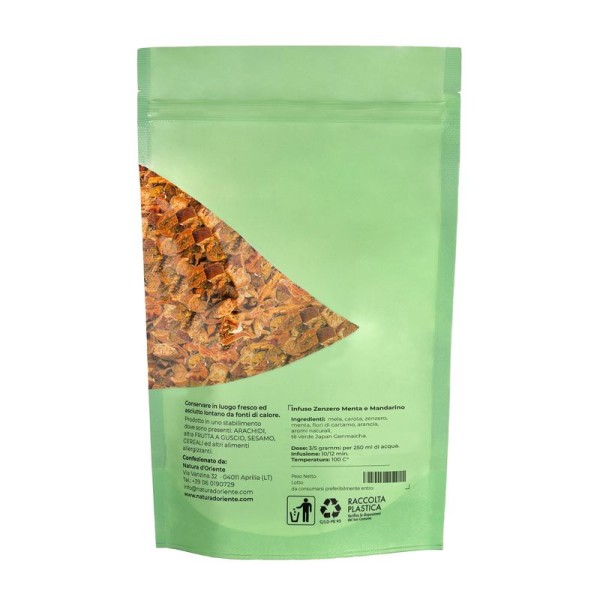







 No reward points for this product.
No reward points for this product.



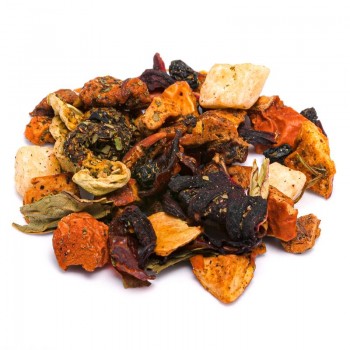


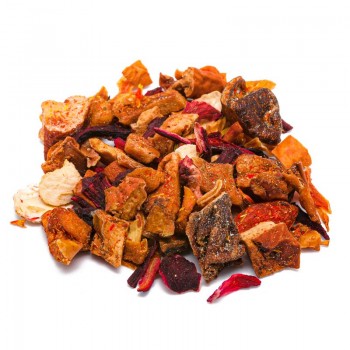



![infuso lime mirtilli rossi [Natura d'Oriente]](https://www.naturadoriente.com/3551-home_default/lime-infused-cranberries.jpg)
